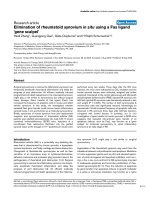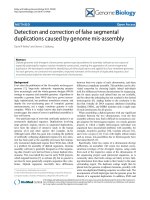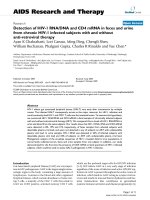Báo cáo y học: " Detection of swine transmissible gastroenteritis coronavirus using loop-mediated isothermal amplification" pptx
Bạn đang xem bản rút gọn của tài liệu. Xem và tải ngay bản đầy đủ của tài liệu tại đây (553.78 KB, 5 trang )
RESEA R C H Open Access
Detection of swine transmissible gastroenteritis
coronavirus using loop-mediated isothermal
amplification
Qin Chen
1*
, Jian Li
2
, Xue-En Fang
1
, Wei Xiong
2
Abstract
A conserved nucleic acid fragment of the nucleocapsid gene of Swine Transmissible Gastroenteritis Coronavirus
(TGEV) was chosen as the target, six special primers were designed successfully. Loop-mediated isothermal amplifi-
cation (LAMP) was developed to detect the TGEV by incubation at 60°C for 1 h and the product specificity was
confirmed by HphI digestion. Standard curves with high accuracy for TGEV quantization was constructed by adding
1 × SYBR greenI in the LAMP reaction. The assay established in this study was found to detect only the TGEV and
no cross-reaction with other viruses, demonstrating its high specificity. By using serial sample dilutions as tem-
plates, the detection limit of LAMP was about 10 pg RNA, 10 times more sensitive than that of PCR and could be
comparable to the nest-PCR.
Background
SwineTransmissibleGastroenteritisCoronavirus
(TGEV), as a member of the coronaviridae, is a kind of
single-stranded RNA virus, which produces villous atro-
phy and enteritis, leading to the serious financial loss to
the w hole pig industry. The traditional detection meth-
ods, including virus isolation, virus immunodiagnostic
assays and PCR tests have the shortcomings, such as
precise instruments requirement, elaborate result analy-
sis demand, high cost, long detection time and so forth,
which prevent these methods from being widely used
[1-4]. Loop-mediated isotherm al amplification (LAMP)
is a novel nucleic acid amplification method, which
amplifies DNA/RNA with high specificity, sensitivity
and rapidity under isothermal condition [5]. It has
already found wide application in RNA virus detection,
such as Foot-and-mouth Disease Virus[6], Swine Vesicu-
lar Disease Virus[7], Taura Syndrome Virus [8], Severe
Acute Respiratory Syndrome Coronavirus and H5N1
Avian Influenza Virus[9,10]. In this study, LAMP
method was applied in developing qualitative and quan-
titative detection system of TGEV, while its specificity
and sensitivity were assessed.
Methods
Samples
SwineTransmissibleGastroenteritisCoronavirus
(TGEV, strain H), Porcine Reproductive and Respiratory
Syndrome Virus (PRRSV), Pesudorabies (PRV), Porcine
Parvovirus (PPV) derived from their passages in cell cul-
ture were provided by Shanghai Entry-Exit Inspection
and Quarantine Bureau (SHCIQ); nucleic acids of Foot-
and-mouth Disease Virus (FMDV) and Classical Swine
Fever Virus (CSFV) were obtained from Chinese Acad-
emy of Inspection and Quarantine (CAIQ).
RNA/DNA extraction
Total genomic RNA was extracted using Trizol Kit
(Invitrogen, USA). DNA was extracted by DNA Blood
Mini Kit (Qia gen, Germany). After elution in 20 μL
Nuclease-free Water, RNA/DNA samples were stored at
-70°C before use. The original concentra tion of RNA/
DNA sample was about 50 ng/μ L.
Target region and LAMP primers designing
Complete genome sequences of fifteen different TGEV
strains/isolates and nine other similar viruses were
obtained from GenBank, and the homology was ana-
lyzed using the Vector NTI. The conserved fragment
with high homology was chosen as the target region
which and used to design the TGEV LAMP primers by
* Correspondence:
1
School of Life Science, Shanghai University, Shanghai 200444, China
Full list of author information is available at the end of the article
Chen et al. Virology Journal 2010, 7:206
/>© 2010 Chen et al; licensee BioMed Central Ltd. This is an Open Access article distributed under the terms of the Creative Commons
Attribution License (http://creativecommons .org/licenses/by/2.0), which permits unrestricted use, distribution, and reproduction in
any medium, provided the original work is properly cited.
the Primer Explorer V3 software http://primerexplorer.
jp/e/.
The construction of standard control
The t arget RNA of TGEV was first reverse transcripted
using Superscript
™ II (Invitrogen, USA) and then ampli-
fied by Pfu DNA polymerase using f orward primer:
GGAAGAGAACTGCAGGTAA and reverse primer:
CCATCTTCCTTTGAAGTCCA. The amplified product
was purified from agarose gels and then cloned into
E. coli JM109 using the pMD18-T vector. The target
plasmid with the original concentration of 8.67 × 10
8
Copies/μ L was extracted by the Plasmid Mini Prepara-
tion Kit and identified by the 260 nm absorption spec-
troscopy, which was then used as the standard for the
quantitative analysis.
LAMP
The LAMP reaction was carried o ut in a volume of
25 μL cont aining 1 × ThermoPol Buffer (New England
Biolabs, USA), 8.0 mM MgSO4, 0.8 M Betaine (Sigma,
Germany), 1.2 mM dNTPs, 0.2 μM each of Outer pri-
mers, 1.6 μM each of Inner primers and 0.4 μMeachof
Loop primers, 5 U AMV Reverse Transcriptase, 8 U of
Bst Polymerase (Large Fragment; New England Biolabs,
USA) with 2 μL total RNA as template. The amplifica-
tion was performed at 60°C in a laboratory water bath
(Kangle, China, 25°C~99°C, with temperature acc uracy
of ±0.3°C) for 1 h.
The amplified products were digested with HphIto
confirm its specificity.
The result of TGEV-LAMP was analyzed by agarose
gel electrophoresis and fluorescence by adding 1 ×
SYBR greenI in the LAMP reaction.
LAMP evaluation
The specificity of TGEV-LAMP w as examined by the
use of RNA (or DNA) extracted from five other pig dis-
ease viruses. The sensitivity of TGEV-LAMP was evalu-
ated by comparing with PCR[4] and Nest-PCR[11],
using 10-serial TGEV RNA dilutions (10
-1
to 10
-7
)as
templates.
Results
LAMP primers
LAMP primers were designed using the Primer Explorer
V3 software based on a conserved fragment of the
nucleocapsid gene (Fig. 1). The primers including Outer
Primers (F3 and B3), Inner primers (FIP and BIP) and
Loop primer (LF and LB) were shown in Table 1.
Detection of TGEV by LAMP
TGEV deprived from the cell culture was first qualita-
tively analyzed by LAMP. Amplification products were
analyzed by agarose gel electrophoresis. As shown in
Fig.2 (Lane 1), amplification could be carried out at 60°C
and showed a ladder-like pattern on the gel while the
negative control gave no bands (Lane 3). The specificity
of the LMAP product was confirmed by HphIdigestion.
Predictable product of the 116-bp motif was resolved on
the gel as theoretical expected (Fig.2, lane 2).
Standard cont rol was used to develop real-time fluor-
escence LAMP for quantitatively analyzing TGEV.
Dynamic curves for T GEV quantification was generated
by serially diluting the st andard control from 8.67 × 10
7
to 8.67 × 10
4
copies/μL(Fig. 3). The log linear regression
plot (standard curves) was obtained b y plotting the
time-to-positive (TTP) values against genome copies.
The correlation coefficients were 0.972 (Fig. 4)
Evaluation of LAMP
Five other pig viruses were used to confirm the specifi-
city of the LAMP for TGEV detection. The results
showed that only TGEV detected gave amplification
products while no amplification available to other
viruses (Fig.5). The sensitivity of LAMP was demon-
strated by comparing with PCR tests using serial dilu-
tions (10
-1
to 10
-7
)ofTGEVRNAsamplesastemplate.
AsshowninFig.6,LAMPandnest-PCRwereableto
detect 10
-5
dilution (about 10 pg RNA), whereas PCR
could only amplify the 10
-4
dilution. Therefore, the sen-
sitivity of TGEV-LAMP could be comparable to nest-
PCR, 10-fold higher than PCR.
Discussion
It is very important to find out a conserved nucleic acid
fragment for designing specific LAMP primers and
developing efficient, accurate LAMP assay [12,13]. In
this study, the nucleic acid sequence homology of 15
TGEV strains/isolates and 9 other similar viruses avail-
able from GenBank were a nalyzed by Vector NTI soft-
ware. The most conserved fragment of 187 bp was
found in the nucleocapsid protein gene which showed
highly homology among different TGEV strains/isolates
(more t han 97%) and low homology among other simi-
lar viruses (less than 52.5%). The TGEV LAMP primers
targeting the conserved sequence were designed success-
fully by the Primer designer V3 software.
The target region was amplified successfully by the
LAMP with a characteristic ladder-like pattern of bands
from 187 bp on the gel. This is because the final pro-
ducts of LAMP are a mixture of stem-loop DNAs with
various stem lengths and cauliflower-like structures with
multiple loops formed by annealing between alternately
inverted repeats of the ta rget sequence in the same
strand [5,14]. After digestion with HphI, 116-bp motif
was resolved on the gel as expected, demonstrating the
specific structure of amplification products, which could
Chen et al. Virology Journal 2010, 7:206
/>Page 2 of 5
also be validated by nucleic acid sequencing. As a kind
of nucleic acid amplification method, LAMP could not
only qualitatively detect the TGEV, but also quantita-
tively analyze the virus. In this study, real time fluores-
cence LAMP for quantitatively detection of TGEV was
established by adding 1 × SYBR greenIin the LAMP
reaction. Three standard curves established by TGEV
standards displayed the good correlation between the
TTP and virus copies, implicating the great potential in
quanlitatively detecting TGEV.
Five other viruses were used in this study to confirm
the specificity of LAMP. The re sults showed no amplifi-
cation in all viruses tested, which makes the LAMP
more accurate and reliable for TGEV detection. The
high specificity of LAMP is most probably attributable
to recognition of the target sequence by six independent
sequences in the initial stage and by four independent
sequences during the second reaction stage. The sensi-
tivity of LAMP was eval uated using various TGEV-RNA
dilutions as templates. The assay exhibited almost
equivalent sensitivity to the nest-PCR and 10-fold higher
than the PCR, indicating that the LAMP is a more
powerful diagnosis tool to detect TGEV in lo wer copy
conditions [11]. In addition, the TGEV-LAMP devel-
oped has a dvantages in its rapid detection and simple
operation. The only equipment required for the reaction
is a water bath or heat block. The assay developed is a
faster detection method for the TGEV detection, only
taking about 1 h, which means the whole diagnosis
Figure 1 The conserved fragment of the nucleocapsid gene from TGEV.
Table 1 TGEV LAMP primers
Primer
name
Type Length/
bp
Sequence(5’to 3’)
TGEV-F3 Forward
Outer
19 GGAAGAGAACTGCAGGTAA
TGEV-B3 Reverse
Outer
20 CCATCTTCCTTTGAAGTCCA
TGEV-FIP Forward
Inner
45 CGAGGTCACTGTCACCAAAATT
TGATGTGACAAGATTTTATGGAG
TGEV-BIP Reverse
Inner
42 GGAGCAGTGCCAAGCATTAC
AAAATGCTAGACACAGATGGAA
TGEV-LF Forward
Loop
17 GGCTGAACTGCTTCTAG
TGEV-LB Reverse
Loop
19 CCACAATTGGCTGAATGTG
Figure 2 Analysis of TGEV by LAMP with agarose gel
electrophoresis. 1, LAMP products of TGEV; 2, LAMP products
digested with Hph I; 3, Negative control.
Figure 3 Dynamic curves of the different TGEV standards.
Chen et al. Virology Journal 2010, 7:206
/>Page 3 of 5
including RNA extraction, amplification and product
detection could be completed within one and a half
hour after receiving of the samples. It is anticipated that
with the advantages of specificity, sensitivity, reliability,
rapidity and easy manipulation, LAMP will turn out be
a powerful molecular tool for the TGEV detection in
practice.
Conclusions
In conclusion, this study demonstrates that the LAMP
method established could detect only the TGEV and no
cross-reaction with other viruses, the detection limit was
about10pgRNA,whichwas10timesmoresensitive
than that of PCR and could be comparable to the nest-
PCR.
Acknowledgements
This study was supported by Chinese national S&T “scientific and
technological support” plan (2009BAK43B30).
Author details
1
School of Life Science, Shanghai University, Shanghai 200444, China.
2
Shanghai Entry-Exit Inspection and Quarantine Bureau, Shanghai 200135,
China.
Authors’ contributions
Conceived and designed the experiments: QC, JL, X-EF. Performed the
experiments: X-EF, JL. Analyzed the data: JL, X-EF, WX. Wrote the paper: QC,
X-EF. All authors read and approved the final manuscript.
Competing interests
The authors declare that they have no competing interests.
Received: 23 April 2010 Accepted: 29 August 2010
Published: 29 August 2010
References
1. Reynolds D, Garwes D: Virus isolation and serum antibody-responses
after infection of cats with transmissible gastroenteritis virus - brief
report. Archives of Virology 1979, 60:161-166.
2. Rodak L, Nevorankova Z, Valicek L, Smitalova R: Use of monoclonal
antibodies in blocking ELISA detection of transmissible gastroenteritis
virus in faeces of piglets. Journal of Veterinary Medicine Series B 2005,
52:105-111.
3. Denac H, Moser C, Tratschin JD, Hofmann MA: An indirect ELISA for the
detection of antibodies against porcine reproductive and respiratory
syndrome virus using recombinant nucleocapsid protein as antigen.
Journal of Virological Methods 1997, 65:169-181.
4. Paton D, Ibata G, Sands J, McGoldrick A: Detection of transmissible
gastroenteritis virus by RT-PCR and differentiation from porcine
respiratory coronavirus. Journal of Virological Methods 1997, 66:303-309.
5. Notomi T, Okayama H, Masubuchi H, Yonekawa T, Watanabe K, Amino N,
Hase T: Loop-mediated isothermal amplification of DNA. Nucleic Acids
Research 2000, 28(12):e63.
6. Dukes JP, King DP, Alexandersen S: Novel reverse transcription loop-
mediated isothermal amplification for rapid detection of foot-and-
mouth disease virus. Archives of Virology 2006, 151:1093-1106.
7. Blomstrom AL, Hakhverdyan M, Reid SM, Dukes JP, King DP, Belak S, Berg
MA:one-step reverse transcriptase loop-mediated isothermal
amplification assay for simple and rapid detection of swine vesicular
disease virus. Journal of Virological Methods 2008, 147:188-193.
8. Kiatpathomchai W, Jareonram W, Jitrapakdee S, Flegel TW: Rapid and
sensitive detection of Taura syndrome virus by reverse transcription
loop-mediated isothermal amplification. Journal of Virological Methods
2007, 146:125-128.
9. Thai H, Le MQ, Vuong CD, Parida M, Minekawa H, Notomi T, Hasebe F,
Morita K: Development and evaluation of a novel loop-mediated
isothermal amplification method for rapid detection of severe acute
respiratory syndrome coronavirus. Journal of Clinical microbiology 2004,
42:1956-1961.
10. Imai M, Ninomiya A, Minekawa H, Notomi T, Ishizaki T, Tu PV, Tien N,
Tashiro M, Odagiri T: Rapid diagnosis of H5N1 avian influenza virus
infection by newly developed influenza H5 hemagglutinin gene-specific
Figure 4 Standard curves of real-time fluorescence TGEV-LAMP.
Figure 5 Specificity of LAMP for TGEV detection .1-6,TGEV,
PRRSV, PRV, CSFV, PPV and FMDV respectively; 7, Negative Control.
Figure 6 Sensitivity of LAMP for TGEV detection.A,LAMP;B,
PCR; C, Nest-PCR; 1-7, TGEV RNA sample at 10
-1
,10
-2
10
-7
dilutions
respectively; 8. Negative Control.
Chen et al. Virology Journal 2010, 7:206
/>Page 4 of 5
loop-mediated isothermal amplification method. Journal of Virological
Methods 2007, 141:173-180.
11. Rodríguez E, Betancourt A, Barrera M, Lee C, Yoo y D: Rapid detection of
swine transmissible gastroenteritis virus by nested polymerase chain
reaction. Rev Salud Anim 2008, 30(2):133-136.
12. Fang Xue-en, Li Jian, Chen Qin: One new method of nucleic acid
amplication —loop-mediated isothermal amplication of DNA. Virologica
Sinica 2008, 23(3):167-172.
13. Fang Xue-en, wei Xiong, Li Jian, Chen Qin: Loop-mediated isothermal
amplication establishment for detection of pseudorabies virus. Journal of
Virological Methods 2008, 151:35-39.
14. Sun ZF, Hu CQ, Ren CH, Shen Q: Sensitive and rapid detection of
infectious hypodermal and hematopoietic necrosis virus (IHHNV) in
shrimps by loop-mediated isothermal amplification. Journal of Virological
Methods 2006, 131:41-46.
doi:10.1186/1743-422X-7-206
Cite this article as: Chen et al.: Detection of swine transmissible
gastroenteritis coronavirus using loop-mediated isothermal
amplification. Virology Journal 2010 7:206.
Submit your next manuscript to BioMed Central
and take full advantage of:
• Convenient online submission
• Thorough peer review
• No space constraints or color figure charges
• Immediate publication on acceptance
• Inclusion in PubMed, CAS, Scopus and Google Scholar
• Research which is freely available for redistribution
Submit your manuscript at
www.biomedcentral.com/submit
Chen et al. Virology Journal 2010, 7:206
/>Page 5 of 5









